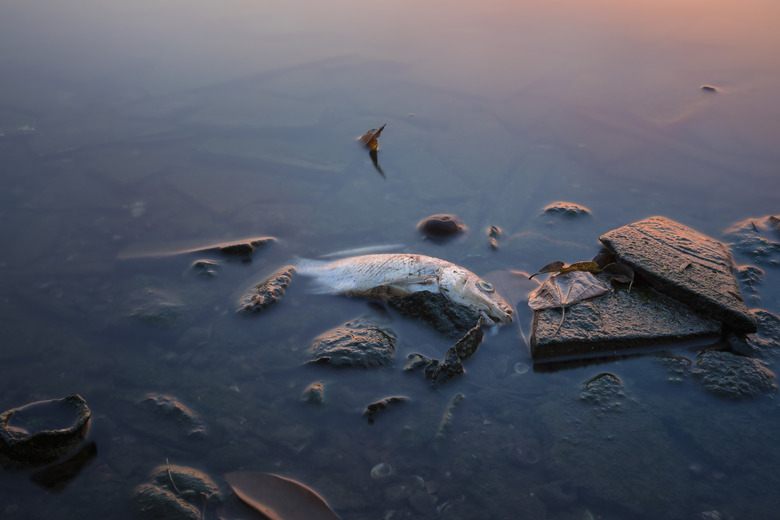How Does Water Pollution Affect Fish?
Whether in fresh or marine waters, fish require untainted food, suitable habitat and adequate oxygen to survive. Any element, whether chemical or natural, that upsets this balance is considered water pollution, or simply a pollutant. Water pollutants are wide-ranging and depend on the region of the world the fish live in, but there are some that are common to many parts of the world.
TL;DR (Too Long; Didn't Read)
Pollution can directly kill or harm fish, or change the makeup of the fish' surroundings, killing off sources of food or causing plant or algae overgrowth that starve the fish of oxygen.
Fertilizer Nutrients Deplete Oxygen
Fertilizer Nutrients Deplete Oxygen
Nitrogen and phosphorus are nutrients that become water pollutants when they enter rivers, lakes and oceans through runoff, such as rain washing excess fertilizer from a lawn into a lake, or a direct discharge when a sewage treatment plant pumps processed sewage into a river. As these excess nutrients build up in a body of water, plants and algae grow at accelerated rates causing plant overgrowth and harmful algal blooms. When plants die, the decay process lowers the dissolved oxygen level in the water to a level too low for fish to survive, resulting in fish kills. When a fish feeds on harmful algae, it ingests toxins that accumulate in its body and are passed on to other fish that eat them.
Pesticides Kill; Heavy Metals Impair
Pesticides Kill; Heavy Metals Impair
Synthetic pesticides, such as weed and bug killers, are toxic to fish in low concentrations resulting in fish mortality and a decline in fish populations. Some fish are more sensitive than others and die at lower concentrations. Pesticides enter fresh and marine waters when applied to a lawn or agriculture field, and excess is washed into the water when it rains, or if the spray drifts when applied. Burning fossil fuels outputs heavy metals into the atmosphere which deposit into bodies of water. Heavy metals in water stunt growth and impair a fish's sense of smell, which hampers its ability to find food or avoid predators.
Food Source Destruction
Food Source Destruction
Fish feed on invertebrates that live in the water. Take away this food source and they either die from starvation or move to a new habitat. These invertebrates include waterborne insects; pesticides are toxic to them in low concentrations. However, if the pesticide does not kill the insect, it is transferred when a fish eats it. Over time, pesticide builds up in the fish until it reaches a fatal level. Sediment is another pollutant that kills invertebrates. A thick layer of silt can smother bottom-dwelling invertebrates. Heavy sediment can also smother fish eggs, reducing their populations.
Flush Effect
Flush Effect
Prescription drugs have lengthen the lifespan of humans; however, each time a drug is ingested, a fraction of it is excreted through urine and feces and flushed down toilet. Most wastewater treatment plants are not capable of removing pharmaceuticals during the treatment process, so drugs pass through the system into rivers and bays or wherever treated wastewater is discharged. A University of Colorado Boulder study shows that fish found in waterways laced with traces of endocrine-disrupting synthetic chemicals exhibit gender-bending; a phenomena in which male fish look and act like females and some possess both male and female organs. The study also shows that waters with traces of antidepressants affect fish behavior.
Cite This Article
MLA
Williams, Diana K.. "How Does Water Pollution Affect Fish?" sciencing.com, https://www.sciencing.com/water-pollution-affect-fish-4565696/. 19 April 2018.
APA
Williams, Diana K.. (2018, April 19). How Does Water Pollution Affect Fish?. sciencing.com. Retrieved from https://www.sciencing.com/water-pollution-affect-fish-4565696/
Chicago
Williams, Diana K.. How Does Water Pollution Affect Fish? last modified March 24, 2022. https://www.sciencing.com/water-pollution-affect-fish-4565696/
